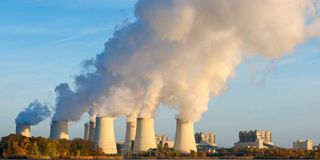Premium
Breath of fresh air for residents of a smoke-filled, crowded Nairobi slum

Residents of Mukuru kwa Njenga are exposed to health hazards from fumes emanating from industries. Fotosearch
In a slum where air pollution is the norm, Caroline Muthoni learned the hard way how to reduce its effects in her household.
She lives in Mukuru kwa Reuben, a slum in Nairobi’s Industrial area.
Residents there are exposed to health hazards from fumes emanating from industries. To make matters worse, residents use unimproved cooking and lighting methods. “I would use a kerosene stove and charcoal, but I stopped because I was given a gas cylinder, which I pay for in instalments. I can now buy gas with as little as Sh10,” she said, referring to the PayGo Energy digital liquefied petroleum gas programme.
“I used to take my son to hospital frequently. He always had a congested chest and would produce black mucous because of inhaling soot, but since I moved to gas, he has been fine,” she said.
Emelda Aoko has an allergy and the industrial smoke made things harder. “I used to sneeze, my chest used to get congested and my children were also affected and that is why I opted for LPG,” said the tailor.
According to Dr Kanyiva Muindi, a researcher at African Population and Health Research Center, although air pollution affects all people, low income groups bear a heavier burden. This is because they are more likely to use cooking fuel and stoves, which are cheaper, but are associated with higher emissions of pollutants.
Indoor pollution
The main source of household air pollution in Kenya is the use of biomass fuels such as firewood or charcoal and kerosene, she said.
Slum neighbourhoods are also under-served in terms of garbage collection and residents resort to burning trash.
Many slum families live in single rooms, where they do the cooking and emissions from stoves remain high indoors. Dr Muindi said poor quality housing, including houses without windows, is typical in such areas leading to high concentrations of air pollutants indoors.
National Environment Management Authority officer in charge of air quality assessment Dr John Mumbo said air quality in the cities was gradually deteriorating due to increased vehicular and industrial emissions. The level of pollution is higher at dumpsites, specific industries and on high-traffic roads.
According to the World Health Organization approximately seven million people worldwide die prematurely each year from air pollution.



